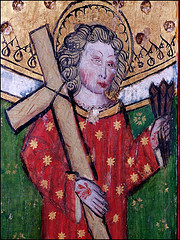Rationale and Research Context
This series of workshop will engage in an interdisciplinary and comparative inquiry into one of the most influential narratives of Christian culture, the myth of ritual murder. The accusation that Jews enacted the Crucifixion on the body of Christian youths became a powerful presence withinin anti-Jewish ideas and practices from its inception in the twelfth-century , through the medieval and early modern centuries, and into modern times. At its heart is the body of a youth, usually a young adolescent boy, out in the world at work, often as an apprentice. Once the accusation against the Jews unfolded and offered a framework for explanation of the youth's death, acts of veneration followed, and punishment too. The youth’s body was ritually buried, the Jews were tried and punished, and the community established routines of commemoration, a cult around what it named as a ‘martyr’ of sorts. The ritual murder narrative and its enactment as social drama is thus a meeting point for the understanding of the suggestive links between youth and collective responses to its violation. The first occasion on which this narrative is known to have been told - mid-twelfh century Norwich - is a unique opportunity to explore the qualities of devotional life in pre-modern Europe.
The case of Norwich, where the body of William was found in 1144, raises all the important questions which new narratives do: about origins, and influence; about the specificity of the local and the universal appeal of what was born in a single medieval town; about the effect of an event deemed miraculous on the community within which it was born and into the future. By no means accepted by all – ritual murder accusations were opposed by the papacy and often doubted by officials, both secular and ecclisiatic – his narrative which combined Youth, Violence and Cult, was nonetheless extremely potent. It became known - and imitated - throughout the Anglo-Norman domain within which it was born, spread to France and the Rhineland, then to Bavaria and further east in the later medieval centuries. It all but disappeared from Protestant Europe in the sixteenth century, but lived on in Catholic Europe, and further east in Russia; it was even taken up in the twentieth century by Muslim communities of the Near East, and was reworked into Nazi propaganda.
The workshops will bring together scholars of all relevant terrains, for an exploration of the Norwich case within the widest possible relevant historical contexts:
![]() Norwich – the city which produced the Youth, the Violence and the Cult
Norwich – the city which produced the Youth, the Violence and the Cult
![]() Anglo-Norman law and administration
Anglo-Norman law and administration
![]() Manuscript history – what CUL Add 3037 can tell us
Manuscript history – what CUL Add 3037 can tell us
![]() narrative and devotional writing
narrative and devotional writing
![]() History of liturgy and performances at cult centres
History of liturgy and performances at cult centres
![]() art and material remains of the cult
art and material remains of the cult
![]() the spread of 'copy cat' cults, in England and on the Continent
the spread of 'copy cat' cults, in England and on the Continent
![]() Historical sociology and comparative insight into collective violence
Historical sociology and comparative insight into collective violence
The Passio Willelmi Norwicensis is a hagiographical account of the death of Young William, which casts it as a case of ritual murder by the Jews of Norwich, together with accounts of some seventy miracles that occurred around his body. The sole surviving manuscript - Cambridge University Library (CUL) Add. 3037 - is frequently cited from The life and miracles of St William of Norwich by Thomas of Monmouth, edited with introduction translation by Augustus Jessopp and Montague Rhodes James in 1896. Miri Rubin is preparing an edition with a new translation, a substantial introduction and notes. The introduction will discuss the case of William and its aftermath in a broad historical context. She will make the newly translated text available through the website in July 2009, and portions of the translation will be made available thereafter. Following the work of the workshops in 2009/10, she hopes to publish a translation by the end of 2011.
The collaboration with the Center for East Anglian Studies at the University of East Anglia is particularly fruitful. Its members will offer local expertise and access to sites (Norwich Cathedral). The historical aim of situating the case of William of Norwich within a wider regional, national and European frame, fits in well with the strategic objectives of CEAS: to situate East Anglia within the broad north-west European sphere.

